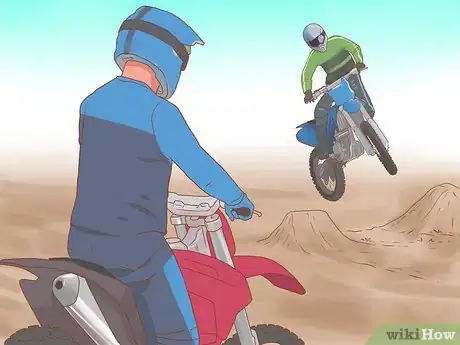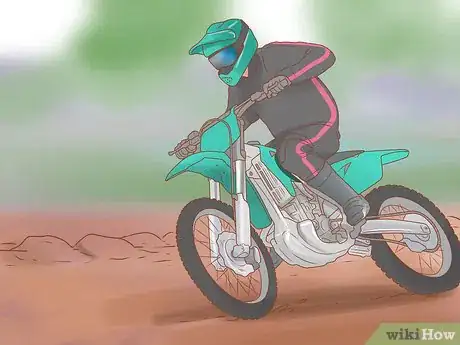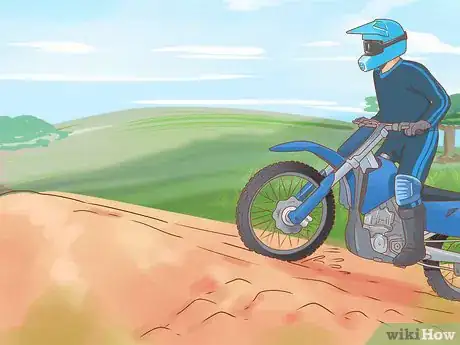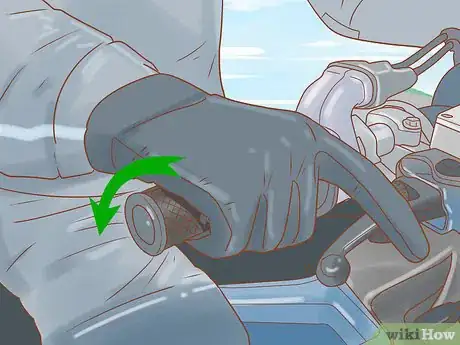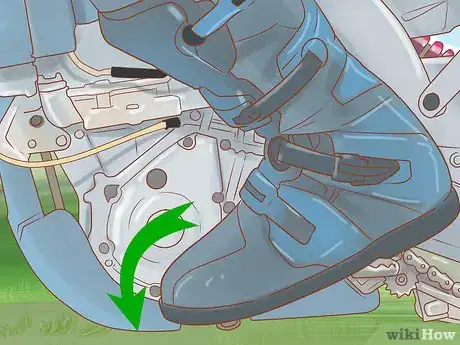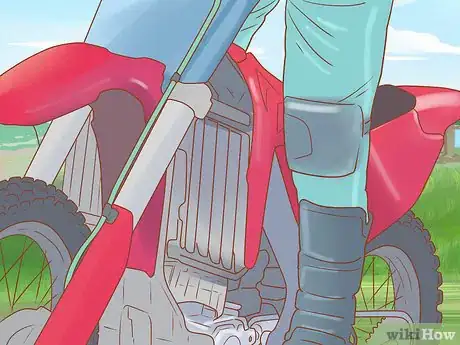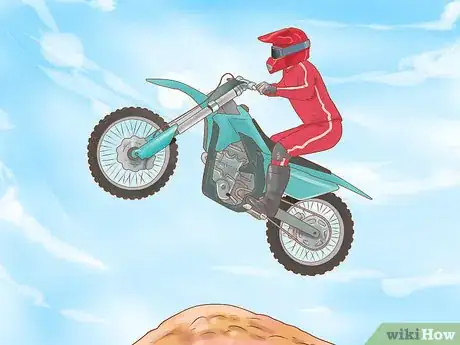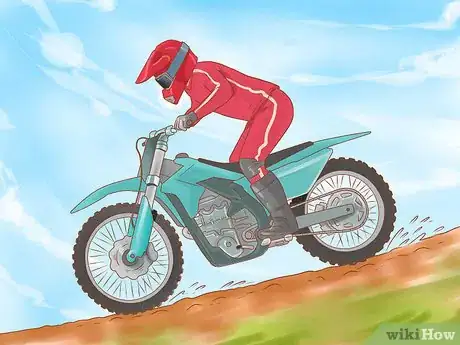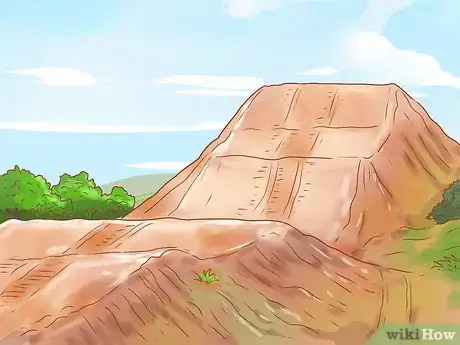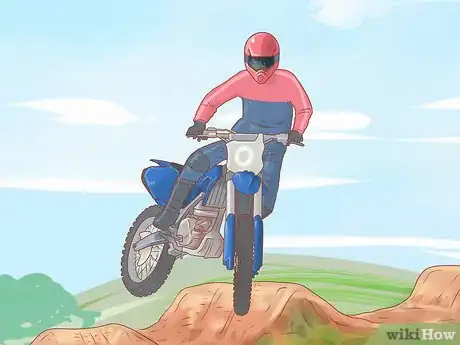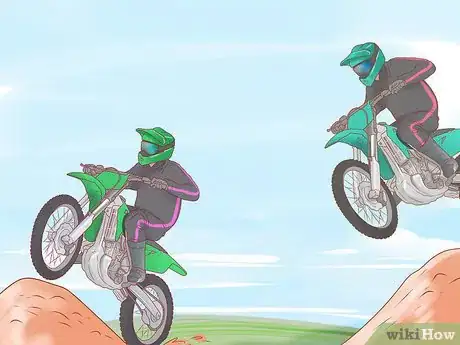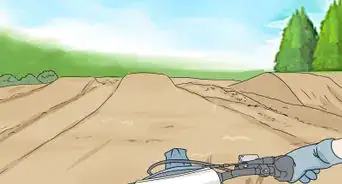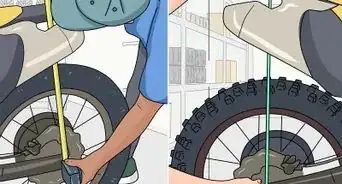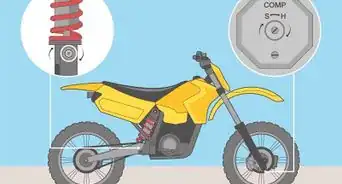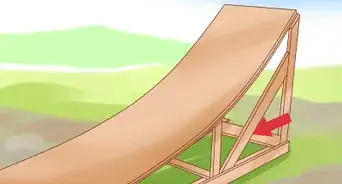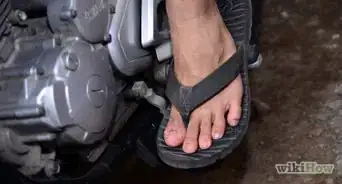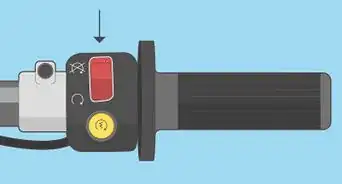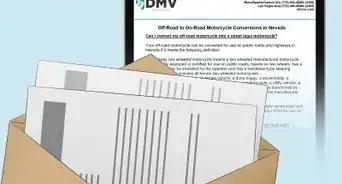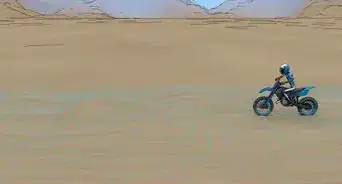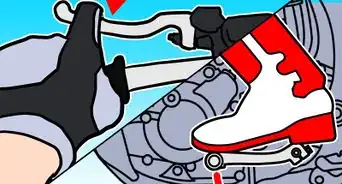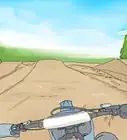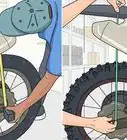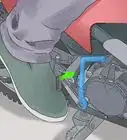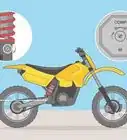This article was co-authored by wikiHow staff writer, Megaera Lorenz, PhD. Megaera Lorenz is an Egyptologist and Writer with over 20 years of experience in public education. In 2017, she graduated with her PhD in Egyptology from The University of Chicago, where she served for several years as a content advisor and program facilitator for the Oriental Institute Museum’s Public Education office. She has also developed and taught Egyptology courses at The University of Chicago and Loyola University Chicago.
There are 14 references cited in this article, which can be found at the bottom of the page.
This article has been viewed 200,142 times.
Learn more...
Doing jumps is one of the most thrilling aspects of riding a dirt bike, but it's also one of the most challenging. It takes a bit of practice and perseverance to learn to jump on a dirt bike, but with the right equipment, posture, and patience, you'll get the hang of it. Start by mastering some basic jumping techniques, then move on to trying different kinds of jumps. There are also tricks you can learn to deal with common mistakes and accidents.
Steps
Using Proper Jumping Technique
-
1Familiarize yourself with the jump before you try it. Try walking over the jump or riding slowly over it to get an idea of what your line of sight will be like and what you can expect during the takeoff and landing.[1] Ideally, you should start with jumps where you can easily see the landing as you perform the jump.[2]
- If possible, watch someone else going over the jump. This will help you get an idea of how fast to approach the jump and what the landing will be like.
- Most step-ups and other basic jumps that you will encounter will be about 4–6 feet (1.2–1.8 m) tall.
Safety precaution: Always wear a full-face helmet, chest protector, and knee braces when you're riding your bike. You're bound to have a few accidents while you're learning to jump, and proper safety gear can help prevent serious injuries.[3]
-
2Take your bike for a few laps to get the engine running. Avoid jumping your bike cold. Mechanical difficulties with the engine at startup can make jumping challenging, or even lead to injuries. Before you jump, start the engine and let it idle for a few minutes to warm up, then drive your bike around slowly for a few laps.
- Letting your bike warm up gives the engine a chance to expand and settle properly before you start riding.
Advertisement -
3Work up to full jumps by driving over them slowly at first. Once your bike is warmed up, drive over the jump you plan to do slowly enough so that you don't go airborne. This will give you a better idea of how to approach the jump and what to expect when you take it at full speed.[4]
- You might start by just driving up and down small ramps or elevations in the track so that you get a feel for what it's like to move from one level to another.[5]
-
4Get into a central standing position. In order to jump safely and effectively, you'll need to get into a stable position. Place the middle of your feet firmly on the foot pegs and stand with your knees slightly bent and your hips directly above the foot pegs. Bend your upper body so that it's at a roughly 45° angle relative to the ground, and grip the handlebars with your elbows bent and sticking out to the sides. Your head should be over the handlebars.[6]
- Try to squeeze the bike with your knees and calves as you approach the jump. This way, your feet are less likely to fly off the pedals, resulting in a potentially dangerous landing.[7]
- Aim for a position that feels stable, but also neutral and relaxed.
-
5Accelerate smoothly as you approach the jump. Getting used to the throttle controls on a dirt bike can take some time and effort. As you drive up to the jump, use a smooth and controlled motion on the throttle to accelerate to the desired speed.[8] Keep a steady grip on the throttle once you reach the desired speed and hold it through the jump.[9]
- Easing off on the throttle too soon can send you into a nose-dive, while accelerating too much can cause you to enter a dangerous mid-air wheelie.
-
6Keep your bike in a low gear during jumps. Learning to shift gears properly on a dirt bike takes a lot of practice—you'll need to develop a sense of what gear works best by experimenting and listening to the sound of your motor. In general, staying in a low gear (such as 3rd) works best when approaching jumps, since it increases your engine's rotations per minute and makes the bike more responsive.[10]
- To upshift, briefly let off on the throttle and squeeze the clutch while you push up on the gear shift peg with your foot. To shift down, push the peg down with your foot.
- In some situations, you might find it helpful to shift in the air during a jump. For example, if you're landing on a straight path after a jump, shifting up in midair can help the bike move ahead more smoothly. If you have to take a turn right after jumping, shift down in the air so the bike decelerates slightly before the turn.[11]
- Don't use the clutch or the gas while shifting in midair.
-
7Grip the bike tightly with your knees as you land. A smooth, safe landing is an important part of any jump. As you land, squeeze tightly with your knees to help keep you stable and ensure that your legs absorb most of the impact (as opposed to your back, arms, or wrists).[12] Keep your wrists straight and continue to hold your elbows out to the side to help distribute the shock evenly through your arms and upper body.[13]
- Whether you should land on your front or back wheel will depend partially on the nature of the jump, but aim for a good balance between the 2.
- Accelerate slightly just before you land to help keep your bike in a straight line.
Avoiding Common Problems
-
1Accelerate in mid-air if you're beginning to pitch too far forward. This can help counter your momentum by lifting up the front wheel. A front wheel crash landing is extremely dangerous. It is typically caused by when you have not accelerated enough at takeoff and can cause your bike to flip on top of you.[14]
- While accelerating in mid-air can help to some extent, there's no guarantee it can fully prevent a nose-dive.
- If you find yourself pitching forward a lot on jumps, practice holding the throttle steadily all the way through the jump.
-
2Apply your back brake if you're headed for a back-wheel landing. This will counter your momentum by dropping the front wheel. When landing from large jumps, use the clutch and don't stall, or you'll lose all control. Release the brake before you land, or you'll likely crash. A back wheel landing is caused by too much acceleration at takeoff.[15]
- For a back-wheel landing from a relatively low height, you can crouch over the tank and down on the bars just before landing to balance out the wheels.
- If you find yourself going into a mid-air wheelie, tap the rear brakes and pull in the clutch. At the same time, lean forward as much as you can.[16]
-
3Land on both wheels if you're going at high speed on a steep decline. Position your body to add additional weight to the front or back wheel as necessary until the bike's wheels are parallel to the ground as you land. A back-wheel landing can flip you over the bars if your back wheel hits a bump or rock as you get close to the ground, while a front wheel landing can cause you to land on your head.[17]
- The right balance and body positioning to land properly on both wheels is also a matter of practice.
Tip: It's a good idea to take a class with a certified instructor before you try dirt bike jumping. They can make sure you're using proper form and technique and help you avoid common mistakes that can lead to injuries.
Trying Different Types of Jumps
-
1Get started with step-ups. A step-up is simply an elevation in the level of the track. As you're getting comfortable with jumping, start by driving over a step-up slowly enough so that you don't go airborne. This will get you used to the sharp change in elevation that's involved in a standard jump. Work your way up to accelerating enough so that you lift off the ground before landing at the top of the step-up.[18]
- As you get more comfortable with jumping, you can also try doing step-downs, where you move from a higher elevation to a lower one.
-
2Move on to tabletops as you get more comfortable. A tabletop is a good starter jump once you're ready to move on from step-ups. This type of jump consists of a takeoff, an elevated plateau (the “tabletop”) and a landing on the other side. Drive over the jump slowly a couple of times, then try approaching it fast enough to get airborne.[19]
- Make sure to maintain smooth throttle control and hold a good body position through the whole jump.
-
3Try doubles or triples once you've mastered the basics. After you've gotten used to doing tabletops, you can try moving up to more complex jumps, such as doubles and triples. These jumps are more difficult because you have to develop an accurate sense of timing and distance. If you overshoot your first jump, you could end up crashing into the face of the next one.[20] Practice driving over the jump slowly multiple times before you attempt to go airborne.
- As you get more experienced, you can practice jumping over 2 or 3 jumps at once instead of jumping each part of the double or triple separately.[21]
Did you know? Some motocross tracks even feature quads—a series of 4 jumps in a row!
Community Q&A
-
QuestionWhat do I do if the front end gets too high over a jump?
 Community AnswerPush your weight forward and position yourself over the handlebars until it comes down. If this doesn't work, your last resort is to pull in the clutch and stab your rear brakes. It'll even out the bike. If you don't pull in the clutch while doing that, your bike can stall in mid-air.
Community AnswerPush your weight forward and position yourself over the handlebars until it comes down. If this doesn't work, your last resort is to pull in the clutch and stab your rear brakes. It'll even out the bike. If you don't pull in the clutch while doing that, your bike can stall in mid-air.
Things You'll Need
- A dirt bike
- A helmet
- Protective gear
- A ramp or jump
References
- ↑ https://dirtbikeplanet.com/dirt-bike-jumping/
- ↑ https://youtu.be/mS0_CfHNeYQ?t=166
- ↑ https://motocrossadvice.com/dirt-bike-gear/essential-dirt-bike-gear/
- ↑ https://www.motosport.com/blog/how-to-jump-a-dirt-bike
- ↑ https://www.motosport.com/blog/how-to-jump-a-dirt-bike
- ↑ https://dirtbikeplanet.com/dirt-bike-riding-tips/
- ↑ https://youtu.be/mS0_CfHNeYQ?t=58
- ↑ https://dirtbikeplanet.com/dirt-bike-jumping/
- ↑ https://youtu.be/mS0_CfHNeYQ?t=105
- ↑ https://motocrossadvice.com/dirt-bike-training/dirt-bike-riding-tips/
- ↑ https://youtu.be/slrlz7Zjop4?t=350
- ↑ https://youtu.be/mS0_CfHNeYQ?t=154
- ↑ https://dirtbikeplanet.com/dirt-bike-jumping/
- ↑ https://dirtbikeplanet.com/dirt-bike-jumping/
- ↑ https://www.motosport.com/blog/5-mistakes-dirt-bike-beginners-make
- ↑ https://dirtbikeplanet.com/dirt-bike-jumping/
- ↑ https://www.motosport.com/blog/5-mistakes-dirt-bike-beginners-make
- ↑ https://www.motosport.com/blog/how-to-jump-a-dirt-bike
- ↑ https://www.motosport.com/blog/how-to-jump-a-dirt-bike
- ↑ https://www.dirtaction.com.au/riding-tip-jumping-doubles/10179.htm
- ↑ https://www.motosport.com/blog/25-most-common-dirt-bike-terms-youll-hear-at-the-track
